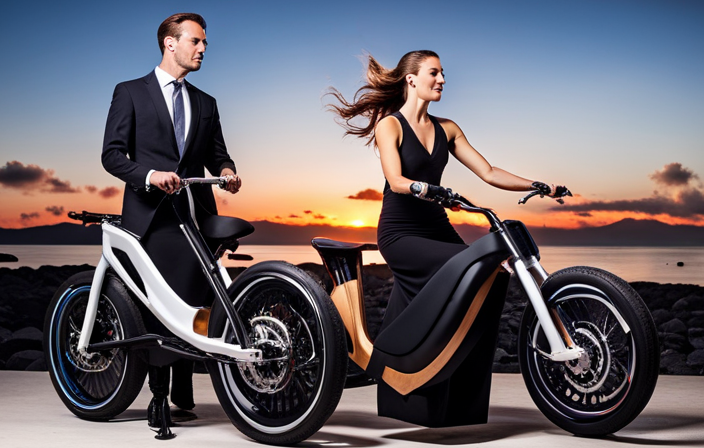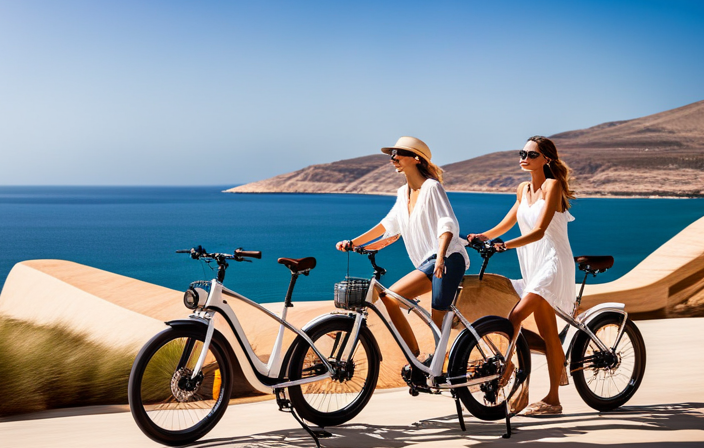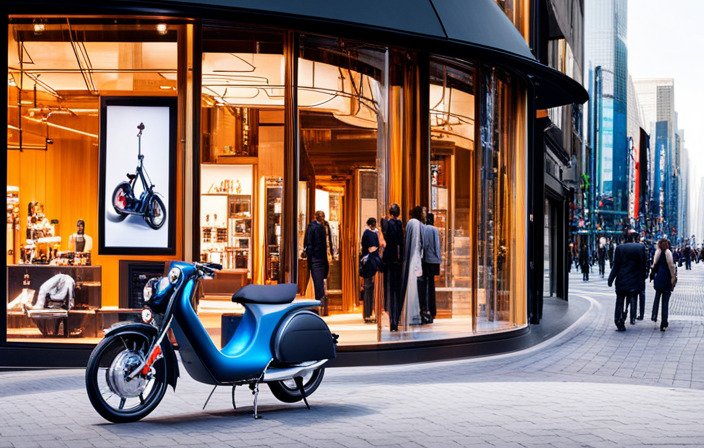Have you ever wondered how many calories you can burn while riding an electric bike? It’s like experiencing the exhilaration of cycling, but with a little extra boost.
In this article, we will explore the calorie-burning potential of electric bikes, comparing it to traditional bicycles and uncovering factors that influence calorie burn. Whether you’re looking to shed some pounds or simply lead a healthier lifestyle, understanding the calorie-burning benefits of electric bike riding can be a game-changer.
So let’s dive in and discover the power of pedaling!
Key Takeaways
- Electric bike assistance allows for a higher average speed and more distance covered.
- Monitoring calorie burn on an electric bike is important for accurate measurement and optimization.
- Electric bike riding can aid in weight loss due to increased calorie burn.
- Electric bike riding offers numerous health benefits, such as improved cardiovascular health and reduced stress.
The Benefits of Riding an Electric Bike
Riding an electric bike can help you burn calories while providing numerous benefits.
Electric bikes, also known as e-bikes, are equipped with a motor that assists with pedaling, making it easier to ride compared to regular bikes. This means that even if you’re not a seasoned cyclist, you can still enjoy the health benefits of biking.
Electric biking is a great way to improve cardiovascular health, build strength, and increase endurance. It’s a low-impact exercise that puts less strain on your joints compared to other forms of exercise.
Additionally, electric biking allows you to ride for longer distances and tackle challenging terrains without feeling exhausted. Understanding the calorie-burning potential of electric bikes is important to maximize your workout.
Understanding the Calorie-Burning Potential of Electric Bikes
When you hop on an e-bike, you’ll quickly discover its potential for burning calories. Electric bikes provide an efficient and enjoyable way to stay active and shed those extra pounds. If you’re looking to track your calorie burn, many e-bikes come equipped with calorie tracking features that allow you to monitor your progress and set fitness goals. Here are some benefits of riding an electric bike for weight loss:
- Increased cardiovascular endurance: Riding an e-bike can get your heart pumping and improve your overall cardiovascular health.
- Low impact exercise: Unlike running or other high-impact exercises, e-biking puts less strain on your joints, making it a suitable option for those with joint issues.
- Longer and more frequent rides: The assistance provided by the electric motor allows you to ride for longer durations and tackle more challenging terrains.
- Fun and enjoyable: E-biking doesn’t feel like a chore; it’s a fun and exciting way to get outdoors and explore.
Understanding the calorie-burning potential of electric bikes is just the first step towards achieving your weight loss goals. In the next section, we’ll explore the factors that influence calorie burn on an electric bike.
Factors that Influence Calorie Burn on an Electric Bike
When it comes to burning calories on an electric bike, there are several factors that come into play.
The speed and intensity of your riding can have a significant impact on the number of calories you burn.
Additionally, the terrain and elevation of your route can also influence calorie burn.
Lastly, your own weight and fitness level will play a role in how many calories you burn while riding an electric bike.
By considering these factors, you can optimize your calorie-burning potential and make the most of your electric bike workouts.
Speed and Intensity of Riding
The speed at which you ride an electric bike will determine the number of calories burned. Here are four ways in which speed and intensity of riding affect calorie burn:
-
Speed training: By increasing your riding speed, you can burn more calories in the same amount of time. Push yourself to go faster and challenge your body.
-
Interval workouts: Incorporating intervals of high-intensity riding into your routine can boost calorie burn. Alternate between periods of intense pedaling and recovery to maximize the benefits.
-
Longer rides at moderate speed: While high-intensity workouts are effective, longer rides at a moderate speed can also help burn calories. Aim for rides that last at least 30 minutes or more.
-
Consistency: Regardless of your speed, consistency is key. Regularly riding your electric bike will help you burn calories and improve overall fitness.
Now let’s move on to the next section about terrain and elevation.
Terrain and Elevation
Riding an electric bike on different terrains and elevations can significantly impact your workout. The effort required to climb hills increases the energy expenditure and can enhance calorie burn compared to riding on flat surfaces. When cycling uphill, your muscles work harder to overcome gravity, resulting in a higher intensity workout. On the other hand, riding on flat terrains allows for a more relaxed and less strenuous ride, which may result in lower calorie burn. Additionally, the level of elevation also plays a role in calorie burn. Cycling at higher elevations, where the air is thinner, requires more effort and can further increase energy expenditure. Understanding how terrain and elevation affect calorie burn can help you tailor your electric bike rides to meet your fitness goals. Now, let’s explore how a rider’s weight and fitness level can impact calorie burn.
Rider’s Weight and Fitness Level
To optimize your workout on an electric bike, your weight and fitness level play a crucial role. Your weight affects the effort required to pedal the bike, impacting the number of calories burned. A heavier rider burns more calories as they need to exert more energy. A higher fitness level allows for a higher intensity workout, resulting in increased calorie burn. Regular exercise and training improve cardiovascular fitness, muscle strength, and endurance, leading to more efficient calorie burning during electric bike rides.
By considering your weight and fitness level, you can tailor your rides to maximize calorie burn and achieve your fitness goals.
Moving on to comparing calorie burn on electric bikes vs. traditional bicycles…
Comparing Calorie Burn on Electric Bikes vs. Traditional Bicycles
When you ride an electric bike, you’ll burn fewer calories compared to riding a traditional bicycle. This is because the electric motor assists you in pedaling, reducing the amount of effort required.
However, it’s important to note that you can still burn a significant number of calories on an electric bike, especially if you ride at higher speeds or tackle challenging terrain.
A calorie burn comparison between electric bikes and traditional bicycles reveals that the latter burns more calories due to the absence of motor assistance.
An efficiency analysis shows that electric bikes are more efficient in terms of energy expenditure, allowing riders to cover longer distances with less effort.
So, while electric bikes may not burn as many calories as traditional bicycles, they still provide a great opportunity for exercise and can be a valuable tool for individuals looking to improve their fitness levels.
Now, let’s explore some tips for maximizing calorie burn on an electric bike.
Tips for Maximizing Calorie Burn on an Electric Bike
To get the most out of your workout on an electric bike, try incorporating interval training into your rides. Interval training involves alternating between high-intensity bursts and low-intensity recovery periods. This type of training has been shown to maximize intensity and increase calorie burn.
For example, you can pedal at a high intensity for 30 seconds, followed by a 1-minute recovery period at a lower intensity. Repeat this cycle several times throughout your ride.
Not only does interval training help to burn more calories, but it also improves cardiovascular fitness and builds endurance. By pushing yourself during the high-intensity intervals, you can increase the overall intensity of your ride and maximize your calorie burn.
Transitioning into the subsequent section, let’s explore the role of electric bike assistance in calorie burn.
The Role of Electric Bike Assistance in Calorie Burn
If you use the assistance of an electric bike, you can still effectively maximize your calorie burn. While electric bike assistance may reduce the physical effort required to pedal, it does not mean you won’t burn calories.
In fact, studies have shown that electric bike riders still burn a significant amount of calories during their rides. The assistance provided by the electric motor allows riders to maintain a higher average speed and cover more distance, resulting in a longer duration of exercise. This increased duration of exercise can lead to a higher calorie burn compared to traditional cycling.
Additionally, the electric bike assistance benefits individuals who may have physical limitations or are new to cycling, allowing them to participate in longer rides and burn more calories.
Transitioning to the subsequent section about tracking and monitoring calorie burn on an electric bike, it’s important to understand how to accurately measure and optimize your calorie burn.
Tracking and Monitoring Calorie Burn on an Electric Bike
Monitoring and tracking your calorie burn on an e-bike is crucial for optimizing your workout. To accurately track your calorie burn, it is important to ensure the tracking accuracy of your fitness device. Some electric bikes come equipped with built-in trackers that can provide accurate readings of your calorie burn.
Additionally, using a heart rate monitor can further enhance the accuracy of your calorie tracking. By monitoring your heart rate during your e-bike rides, you can get a better understanding of the intensity of your workout and the corresponding calorie burn. This information can help you adjust your workouts and set specific goals for weight loss or fitness improvement.
Transitioning into the next section, understanding the potential for weight loss with electric bike riding is essential for creating an effective workout plan.
The Potential for Weight Loss with Electric Bike Riding
When it comes to weight loss, electric bike riding can be an effective exercise option. Not only does it provide a fun and enjoyable way to get moving, but it can also help you shed those extra pounds. Here are a few weight loss benefits of riding an electric bike:
-
Increased calorie burn: Riding an electric bike can help you burn calories, aiding in weight loss.
-
Lower impact on joints: Unlike running or high-impact exercises, electric bike riding puts less stress on your joints, making it a suitable option for individuals with joint issues.
-
Longer duration of exercise: Electric bikes can help you ride for longer distances and durations, allowing you to burn more calories and increase your overall exercise time.
-
Sustainable exercise routine: The ease of riding an electric bike can make it a sustainable form of exercise, helping you maintain a consistent workout routine.
By incorporating electric bike riding into your fitness regimen, you can enjoy the weight loss benefits while having fun.
And that’s not all, there are many other health benefits of electric bike riding to explore in the next section.
Other Health Benefits of Electric Bike Riding
Riding an electric bike offers a range of health benefits beyond just weight loss. One of the key benefits is improved cardiovascular health. When you ride an electric bike, you engage in cardiovascular exercise, which strengthens your heart and improves blood circulation. This can help reduce the risk of heart disease, lower blood pressure, and increase overall fitness levels.
Additionally, electric bike riding can also improve mental health by reducing stress and anxiety. It provides an opportunity to spend time outdoors, enjoy nature, and clear your mind.
Furthermore, electric bike riding is a low-impact exercise, meaning it puts less strain on your joints compared to other forms of exercise like running or high-intensity workouts. This makes it a great option for people with joint pain or those recovering from injuries.
In conclusion, embracing the calorie-burning potential of electric bikes can lead to numerous health benefits for both the body and mind.
Conclusion: Embracing the Calorie-Burning Potential of Electric Bikes
In conclusion, embracing the calorie-burning potential of electric bikes can have a significant impact on your overall health and well-being. Electric bikes provide a great opportunity to maximize efficiency while reaping the health benefits of exercise.
Not only do they offer a fun and convenient mode of transportation, but they also provide a low-impact workout that can burn calories and improve cardiovascular health.
By incorporating electric bike riding into your daily routine, you can increase your physical activity levels and burn calories without putting excessive strain on your joints. This can be especially beneficial for individuals with joint issues or those who are just starting their fitness journey. Additionally, electric bikes allow you to adjust the level of assistance provided, allowing you to gradually increase your fitness level over time.
Regular electric bike riding can help improve muscle strength and endurance, boost mood and mental well-being, and contribute to weight management. It is a sustainable and enjoyable way to stay active and maintain a healthy lifestyle.
So, why not embrace the calorie-burning potential of electric bikes and achieve your health and fitness goals?
Frequently Asked Questions
Are electric bikes more effective at burning calories compared to traditional bicycles?
Electric bikes are more efficient than traditional bikes for burning calories due to their electric assistance. However, the impact of terrain should be considered, as uphill rides can still provide a good calorie-burning workout.
Can electric bike assistance be turned off to increase calorie burn?
Turning off electric bike assistance can significantly increase calorie burn, allowing you to feel the burn and unleash your inner fitness warrior. It amplifies the benefits of electric bike calorie burn, making your workout more intense and effective.
How accurate are calorie tracking devices on electric bikes?
Calorie tracking devices on electric bikes have limitations in accuracy. Factors like weight, intensity of the workout, and individual metabolism affect calorie burn. It is advisable to use these devices as a relative measure rather than an absolute value.
Can electric bike riding help with weight loss?
Electric bike riding can be an effective way to lose weight and improve cardiovascular health. Compared to a treadmill, an electric bike provides a more enjoyable and low-impact workout while still burning calories.
Are there any other physical health benefits of riding an electric bike?
Riding an electric bike has numerous physical health benefits. It can improve cardiovascular health by increasing heart rate and blood flow. Additionally, it can increase muscle strength in the lower body, especially in the legs and glutes.
Conclusion
In conclusion, hopping on an electric bike is like embarking on a thrilling adventure through a calorie-burning wonderland.
Just like a magical journey, where each step takes you closer to your destination, each pedal stroke on an electric bike propels you towards a healthier, fitter version of yourself.
With the power of technology and the joy of riding, you can effortlessly melt away those unwanted calories while enjoying the scenic views.
So, embrace the enchanting allure of electric bikes and let them guide you towards a healthier, more vibrant life.









